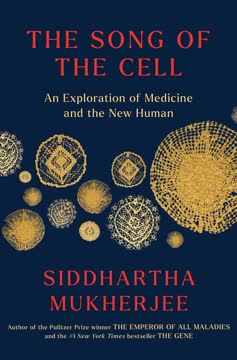Key Takeaways
1. Heredity is complex and multifaceted, extending beyond simple genetic inheritance
"Heredity, in other words, is more than one thing."
Multifaceted nature of heredity. Heredity encompasses not only the genes we inherit from our parents but also the complex processes that occur within our bodies as cells divide and differentiate. This includes:
- Vertical inheritance: Genes passed down from parents to offspring
- Horizontal inheritance: Gene transfer between unrelated organisms (e.g., bacteria)
- Epigenetic inheritance: Changes in gene expression without altering DNA sequence
- Cellular inheritance: How cells pass on their characteristics during division
The study of heredity has evolved from simple observations of family resemblances to a sophisticated understanding of molecular genetics, revealing layers of complexity in how traits are passed down and expressed.
2. The history of heredity research is marked by scientific breakthroughs and ethical missteps
"We are driven to the absurd conclusion that a majority of our ancestors were mentally retarded."
Evolving understanding of heredity. The history of heredity research is a journey of scientific progress intertwined with ethical challenges:
- Early theories: From Hippocrates' blending inheritance to Mendel's pea experiments
- Eugenics movement: Misuse of heredity concepts to justify discrimination and sterilization
- Discovery of DNA structure: Watson, Crick, and Franklin's groundbreaking work
- Modern genomics: Genome sequencing and genome-wide association studies
Ethical considerations:
- Misuse of heredity concepts to justify racism and discrimination
- Privacy concerns in the era of personal genomics
- Ethical implications of gene editing technologies like CRISPR
3. Height and intelligence are influenced by both genes and environment in intricate ways
"Height was a strongly heritable trait in the early 1900s, when scientists first began to measure it. Intelligence was as well. Today, both remain heritable."
Nature vs. nurture debate. Both height and intelligence are complex traits influenced by numerous factors:
Height:
- Heritability: Estimated at 80% in developed countries
- Environmental factors: Nutrition, health care, socioeconomic status
- Historical trends: Flynn effect (increasing average height over time)
Intelligence:
- Heritability: Estimated at 50-80%, increasing with age
- Environmental factors: Education, stimulation, socioeconomic status
- Measurement challenges: Defining and quantifying intelligence
Gene-environment interactions play a crucial role in both traits, making it impossible to separate nature from nurture entirely. Understanding these interactions is essential for developing effective interventions and policies.
4. Race is a social construct with no meaningful biological basis
"To talk of 'high I.Q. genes,' or to try to disentangle the genetic programme from the environment in which it is expressed is both disingenuous and misleading."
Debunking racial biology. Scientific research has consistently shown that race is a social construct rather than a biological reality:
- Genetic diversity: More genetic variation exists within racial groups than between them
- Continuous variation: Human traits vary gradually across geographic regions, not in discrete categories
- Historical context: Racial categories have changed over time and differ between cultures
Implications:
- Race-based medicine: Limited usefulness and potential for harm
- Addressing health disparities: Focus on social determinants of health rather than genetic differences
- Combating racism: Using scientific evidence to challenge racist ideologies
5. Ancient DNA reveals complex human migration and mixing patterns
"Everyone who was alive five thousand years ago who has any living descendants is an ancestor of everyone alive today."
Human prehistory unveiled. Ancient DNA analysis has revolutionized our understanding of human history:
Key findings:
- Multiple waves of migration out of Africa
- Interbreeding between Homo sapiens and other hominins (Neanderthals, Denisovans)
- Complex population mixing and replacement events in Europe and Asia
Implications:
- Challenging traditional views of distinct racial or ethnic groups
- Revealing shared ancestry among seemingly disparate populations
- Providing insights into the spread of languages, cultures, and technologies
This research underscores the interconnectedness of human populations and the dynamic nature of our genetic heritage.
6. Epigenetics and gene-environment interactions challenge simplistic views of heredity
"The environment's power isn't limited to lowering intelligence test scores, however. It can—under certain circumstances—lift them up."
Beyond DNA sequence. Epigenetics and gene-environment interactions reveal additional layers of hereditary complexity:
Epigenetics:
- Chemical modifications to DNA that affect gene expression without changing the sequence
- Potential for transgenerational inheritance of epigenetic marks
Gene-environment interactions:
- Same genes can lead to different outcomes in different environments
- Environmental factors can influence gene expression throughout life
Examples:
- Dutch Hunger Winter: Prenatal exposure to famine linked to health outcomes in adulthood
- Stress and trauma: Effects on gene expression and potential transgenerational impacts
These findings highlight the plasticity of our genetic inheritance and the importance of environmental factors in shaping traits and health outcomes.
7. Understanding heredity has profound implications for medicine, education, and society
"Such efforts need no genetic information—or even I.Q. testing—and are likely to be hindered by the hereditary concept of intelligence."
Practical applications of heredity research. Our evolving understanding of heredity has far-reaching implications:
Medicine:
- Personalized medicine based on genetic profiles
- Gene therapy and targeted treatments for genetic disorders
- Prenatal genetic testing and counseling
Education:
- Recognizing the limits of genetic determinism in academic potential
- Developing interventions that account for both genetic and environmental factors
- Addressing socioeconomic disparities that affect cognitive development
Society:
- Challenging racial and ethnic stereotypes based on genetic misconceptions
- Informing policies on public health, environmental protection, and social equity
- Ethical considerations in genetic privacy, discrimination, and enhancement
While genetic information can provide valuable insights, it's crucial to consider the complex interplay between genes and environment in shaping human traits and potential. Effective policies and interventions should address both biological and social factors to promote health, education, and equality.
Last updated:
FAQ
What's She Has Her Mother's Laugh about?
- Exploration of heredity: The book delves into the science of heredity, tracing its history from ancient beliefs to modern genetics. It examines how traits are passed down through generations and the implications of these processes on society.
- Intertwined stories: Carl Zimmer weaves personal narratives with scientific discoveries, illustrating the human impact of genetic research. The book includes stories of individuals affected by genetic conditions and the societal consequences of eugenics.
- Science and pseudoscience: Zimmer contrasts legitimate scientific advancements in genetics with the harmful pseudosciences that have misused heredity, such as eugenics and racial ideologies. This duality highlights the potential for both progress and peril in understanding heredity.
Why should I read She Has Her Mother's Laugh?
- Engaging storytelling: Zimmer is known for his ability to make complex scientific topics accessible and engaging. His narrative style combines personal anecdotes with scientific explanations, making the book both informative and enjoyable.
- Timely relevance: The book addresses contemporary issues surrounding genetics, such as genetic testing and the ethical implications of genetic engineering. Understanding these topics is increasingly important in today's society.
- Broad appeal: Whether you are a science enthusiast or someone interested in personal stories, the book offers something for everyone. It invites readers to reflect on their own family histories and the science behind them.
What are the key takeaways of She Has Her Mother's Laugh?
- Heredity is complex: The book emphasizes that heredity is not just about genes; it encompasses a wide range of biological and environmental factors. Zimmer encourages readers to rethink simplistic notions of inheritance.
- Impact of genetics on society: Zimmer discusses how genetic research has shaped societal views on race, intelligence, and disability. He warns against the misuse of genetic information for discriminatory practices.
- Personal connection to science: The author illustrates how genetics affects individual lives, making the science personal and relatable. This connection fosters a deeper understanding of the implications of heredity.
What are the best quotes from She Has Her Mother's Laugh and what do they mean?
- “The whole subject of inheritance is wonderful.” This quote reflects the awe and complexity of heredity, suggesting that understanding it can lead to profound insights about life and identity.
- “Heredity continues within us, as a single cell gives rise to a pedigree of trillions of cells.” This highlights the idea that heredity is not just about familial connections but also about the biological processes that shape our very being.
- “We should try to redefine the word heredity, to create a more generous definition that’s closer to nature than to our demands and fears.” Zimmer advocates for a broader understanding of heredity that includes environmental influences and the interconnectedness of life.
How does She Has Her Mother's Laugh address the history of genetics?
- Historical context: Zimmer traces the evolution of genetic science from early theories of inheritance to the modern understanding of DNA. He discusses key figures and milestones that shaped the field.
- Pseudoscience and eugenics: The book critically examines how genetics has been misused in the past, particularly through eugenics and racial theories. Zimmer highlights the dangers of applying genetic concepts without ethical considerations.
- Lessons learned: By reflecting on the history of genetics, Zimmer encourages readers to be cautious about how genetic information is used in society today. He emphasizes the importance of ethical responsibility in scientific research.
What role do personal stories play in She Has Her Mother's Laugh?
- Humanizing science: Zimmer uses personal narratives to illustrate the real-world implications of genetic research. These stories make the science relatable and emphasize its impact on individuals and families.
- Diverse perspectives: The book includes a variety of voices, from scientists to individuals affected by genetic conditions. This diversity enriches the narrative and provides a comprehensive view of heredity.
- Emotional resonance: Personal stories evoke empathy and understanding, allowing readers to connect emotionally with the scientific concepts discussed. This connection enhances the overall impact of the book.
How does She Has Her Mother's Laugh explain the concept of heredity?
- Definition of heredity: Zimmer defines heredity as the process by which traits are passed from parents to offspring, encompassing both genetic and environmental factors. He emphasizes that it is a complex interplay rather than a straightforward transmission.
- Mechanisms of inheritance: The book discusses various mechanisms of inheritance, including Mendelian genetics and modern understandings of DNA. Zimmer explains how these mechanisms influence traits and behaviors.
- Broader implications: Zimmer argues that heredity extends beyond genes to include cultural and environmental influences. He encourages readers to consider how these factors shape identity and society.
What are the dangers of misunderstanding heredity as discussed in She Has Her Mother's Laugh?
- Eugenics and discrimination: Zimmer warns that misinterpretations of heredity can lead to harmful ideologies, such as eugenics, which promote discrimination based on perceived genetic superiority. This has historically resulted in significant social injustices.
- Oversimplification of traits: The book cautions against oversimplifying complex traits, such as intelligence or behavior, as purely genetic. Such views can lead to fatalistic attitudes and neglect of environmental influences.
- Ethical concerns: Zimmer highlights the ethical dilemmas posed by genetic testing and manipulation. He urges readers to consider the moral implications of using genetic information in ways that could harm individuals or communities.
How does She Has Her Mother's Laugh relate to contemporary genetic issues?
- Genetic testing: The book discusses the rise of genetic testing and its implications for individuals and families. Zimmer explores how this technology can empower people but also raise ethical concerns.
- CRISPR and gene editing: Zimmer addresses the advancements in gene editing technologies, such as CRISPR, and their potential to reshape heredity. He emphasizes the need for careful consideration of the consequences of such powerful tools.
- Social implications: The author reflects on how contemporary genetic issues intersect with societal values, including race, disability, and identity. He encourages readers to engage critically with these topics as they evolve.
What scientific concepts are central to She Has Her Mother's Laugh?
- Mendelian genetics: The book explains Mendel’s principles of inheritance, including dominant and recessive traits. Zimmer illustrates how these concepts laid the groundwork for modern genetics.
- DNA and genes: Zimmer discusses the structure and function of DNA, emphasizing its role in heredity. He explains how genes encode traits and how mutations can lead to genetic disorders.
- Epigenetics: The book touches on the emerging field of epigenetics, which studies how environmental factors can influence gene expression. Zimmer highlights the complexity of heredity beyond simple genetic inheritance.
How does She Has Her Mother's Laugh encourage readers to rethink heredity?
- Complexity of inheritance: Zimmer challenges readers to move beyond simplistic views of heredity as solely genetic. He emphasizes the importance of considering environmental and cultural influences on traits.
- Interconnectedness of life: The book promotes a view of heredity that recognizes the interconnectedness of all living beings. Zimmer encourages readers to appreciate the shared history and biology that bind us together.
- Ethical responsibility: Zimmer calls for a more ethical approach to genetic research and its applications. He urges readers to consider the implications of their understanding of heredity on society and future generations.
Review Summary
She Has Her Mother's Laugh is a comprehensive exploration of heredity, from ancient concepts to modern genetic science. Zimmer weaves historical anecdotes with scientific discoveries, covering topics like eugenics, epigenetics, and CRISPR. Readers praise the book's accessibility, engaging storytelling, and thorough research. While some found it overly long, most appreciated its depth and breadth. The book challenges simplistic notions of inheritance, revealing the complex interplay of genes, environment, and culture in shaping who we are.
Similar Books










Download PDF
Download EPUB
.epub digital book format is ideal for reading ebooks on phones, tablets, and e-readers.






